Kitsman
Kitsman (Ukrainian: Кіцмань, romanized: Kicmań, IPA: [ˈkitsmɐnʲ]; Romanian: Coțmani; German: Kotzman; Yiddish: קאצמאן, romanized: Kotzman) is a city located in Chernivtsi Raion, Chernivtsi Oblast, in the historical region of Bukovina of western Ukraine. It hosts the administration of Kitsman urban hromada, one of the amalgamated hromadas of Ukraine.[1] The town is about 20 km (12 mi) northwest from Chernivtsi on the road to Zalishchyky. Population: 6,179 (2020 est.)[2]
Kitsman
Кіцмань Coțmani • קאצמאן | |
|---|---|
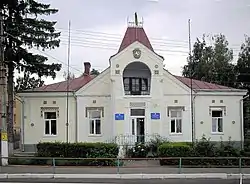 Kitsman City Hall | |
 Flag 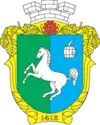 Coat of arms | |
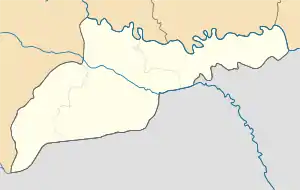 Kitsman Location of Kitsman  Kitsman Kitsman (Ukraine) | |
| Coordinates: 48°26.5′N 25°45.6′E | |
| Country | |
| Oblast | |
| Raion | Chernivtsi Raion |
| First chronicled | 1413 |
| City rights | 1798 |
| Government | |
| • City Head | Serhij Buleha |
| Elevation | 232 m (761 ft) |
| Population (2020) | |
| • Total | 6,179 |
| Time zone | UTC+2 (EET) |
| • Summer (DST) | UTC+3 (EEST) |
| Postal code | 59300-06 |
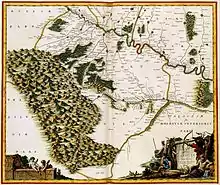
Name
The old surname Kitzman/Kotzman (and variations thereof) originated in Jewish culture, which had gradually become more common in parts of western Ukraine. The name was occupational and derivative of Hebrew roots; shortening the phrase kohen Tsedek ("priest of righteousness"). It was widespread in the Yiddish culture, where -man was the standard suffix applied to commoners' surnames.[3]
History
![]() Moldavia 1413–1775
Moldavia 1413–1775
![]() Habsburg Monarchy 1775–1804
Habsburg Monarchy 1775–1804
![]() Austrian Empire 1804–1918
Austrian Empire 1804–1918
![]() Kingdom of Romania 1918–1940
Kingdom of Romania 1918–1940
![]() Soviet Union (Ukrainian SSR) 1940–1941
Soviet Union (Ukrainian SSR) 1940–1941
![]() Kingdom of Romania 1941–1944
Kingdom of Romania 1941–1944
![]() Soviet Union (Ukrainian SSR) 1944–1991
Soviet Union (Ukrainian SSR) 1944–1991
![]() Ukraine 1991–present
Ukraine 1991–present
The first historical mention of Kitsman is dated to 1413, which also appears on the city's crest. Kuzmyn Forest (Codrii Cozminului), woods are situated between Siret and Prut valleys next to the town are named so, because they are traversed by the roads that connect Suceava, the Middle Ages' capital of the Principality of Moldavia, with what was then its boundary town of Cozmin / Kozmyn (modern village Valia Kuzmyna in Chernivtsi Raion).
In the Austrian period (1774-1918), Kitsman (known as Kotzman / Kotzmann in German), as part of the Duchy of Bukovina, was the seat of the planning section of the district administration and it had a district court and a state gymnasium, where instruction was given in the Ruthenian (Ukrainian) language. The Ruthenian (Ukrainian) farmers from the 13 surrounding villages brought their produce to the market in Kitsman.
During the period of Romanian rule (1918-1944), the Romanian authorities viewed both the Ukrainians (Ruthenes) and the Jews as enemies of the state whose suppression was one of the goals of the state.
A local newspaper is published here since June 1, 1941.[4]
In January 1989 the population was 9500 people.[5][6]
In January 2013 the population was 6762 people.[7]
Until 18 July 2020, Kitsman served as an administrative center of Kitsman Raion. The raion was abolished in July 2020 as part of the administrative reform of Ukraine, which reduced the number of raions of Chernivtsi Oblast to three. The area of Kitsman Raion was split between Chernivtsi Raion and Vyzhnytsia Raion, with Kitsman being transferred to Chernivtsi Raion.[8][9]
Notable figures
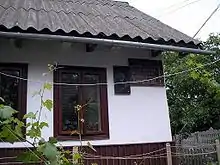
Remarkably, Kitsman is the birthplace of several nationally well-known musicians including Volodymyr Ivasyuk and Ani Lorak.
Jewish community
Out of the population of 6000 that Kitsman had, approximately 700 (11.6%) were Jews who had immigrated from nearby areas of Galicia at the beginning of the 19th century and who dealt mainly with commerce in agricultural products. They also were occupied as craftsmen and were practically the only representatives of the intellectual professions. There were Jews in the ranks of the judges and in the bureaucracy. To name a few, Nathan Seidmann, a clerk in the planning section of the district administration in Kitsman who in his time as a member of the executive committee 2 during the years 1921 to 1927 and intermittently as chairman of the Zionist organization, performed notable service. Before 1914, the Jews and the Ruthenian (Ukrainian) population of the town and the surrounding villages co-existed in peace.
References
- "Кицманская громада" (in Russian). Портал об'єднаних громад України.
- "Чисельність наявного населення України (Actual population of Ukraine)" (PDF) (in Ukrainian). State Statistics Service of Ukraine. Retrieved 30 September 2020.
- Kitzman family, House of Names
- № 3270. Советская жизнь // Летопись периодических и продолжающихся изданий СССР 1986 - 1990. Часть 2. Газеты. М., «Книжная палата», 1994. стр.427
- Всесоюзная перепись населения 1989 г. Численность городского населения союзных республик, их территориальных единиц, городских поселений и городских районов по полу
- Кицмань // Большой энциклопедический словарь (в 2-х тт.). / редколл., гл. ред. А. М. Прохоров. том 1. М., "Советская энциклопедия", 1991. стр.585
- Чисельність наявного населення України на 1 січня 2013 року. Державна служба статистики України. Київ, 2013. стор.108
- "Про утворення та ліквідацію районів. Постанова Верховної Ради України № 807-ІХ". Голос України (in Ukrainian). 2020-07-18. Retrieved 2020-10-03.
- "Нові райони: карти + склад" (in Ukrainian). Міністерство розвитку громад та територій України.
